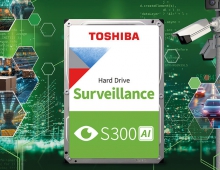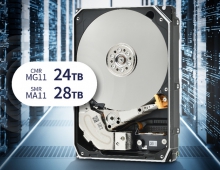
Toshiba progress on Blue-laser
Toshiba will demonstrate its blue-laser-based storage technology at Tokyo's giant Ceatec
exhibition held at Makuhari Messe, Chiba prefecture, from October 7-11.
The company will show a prototype blue-laser diode for optical disc systems. It is
expected to hit the market around 2006. The new technology is several times more powerful
than current commercial models, and has what Toshiba claims is the lowest noise of any
such laser diode yet developed.
Lasers are used in optical disc systems to read and write information to the disc. The wavelength of the light produced by the laser is one of the main factors in determining the amount of data that can be stored on a disc. The shorter the wavelength, the smaller the light spot made on the disc surface and so less space is required to store one bit of information and more can be stored on a disc.
Almost all current optical disc systems, including CD and DVD, use lasers that emit light in the red or infrared spectrum. The CD system holds around 650MB of data and uses a 780-nanometer wavelength laser while the 4.7GB DVD format uses a laser with a wavelength of around 640 nanometers.
As storage technology moves onward, manufacturers are working with blue and blue-violet laser systems. Both Sony's Blu-ray system and Toshiba and NEC's proposed Advanced Optical Disc system use lasers with a wavelength around 405 nanometers, achieving storage capacities of between 23GB and 36GB per disc.
Toshiba's new laser has a similar wavelength, so it won't help improve on data density – but its high output power and low noise will enable reading and writing to take place at higher speed than the basic version of the systems. In current CD and DVD systems, more-powerful lasers have helped engineers do exactly the same thing, so higher speed drives, such as 4x or 12x or 24x models, are now available.
Main Specifications
Max. Optical Output: 200mW (Continuos wave mode at 25 degrees C)
Relative Intensity Noise: -132 dB/Hz (at 3mW)
Laser Wavelength: 409 nanometer
Threshold Current: 35 mA
Operation Current: 164 mA
Beam Angle (parallel): 12.4 degree
Beam Angle (perpendicular): 25.8 degree
Max. Operational Case Temperature: 100 degrees C
Toshiba expects faster versions of blue laser systems will be on the market around 2006, said Makoto Yasuda, a spokesman for Toshiba.
Lasers are used in optical disc systems to read and write information to the disc. The wavelength of the light produced by the laser is one of the main factors in determining the amount of data that can be stored on a disc. The shorter the wavelength, the smaller the light spot made on the disc surface and so less space is required to store one bit of information and more can be stored on a disc.
Almost all current optical disc systems, including CD and DVD, use lasers that emit light in the red or infrared spectrum. The CD system holds around 650MB of data and uses a 780-nanometer wavelength laser while the 4.7GB DVD format uses a laser with a wavelength of around 640 nanometers.
As storage technology moves onward, manufacturers are working with blue and blue-violet laser systems. Both Sony's Blu-ray system and Toshiba and NEC's proposed Advanced Optical Disc system use lasers with a wavelength around 405 nanometers, achieving storage capacities of between 23GB and 36GB per disc.
Toshiba's new laser has a similar wavelength, so it won't help improve on data density – but its high output power and low noise will enable reading and writing to take place at higher speed than the basic version of the systems. In current CD and DVD systems, more-powerful lasers have helped engineers do exactly the same thing, so higher speed drives, such as 4x or 12x or 24x models, are now available.
Main Specifications
Max. Optical Output: 200mW (Continuos wave mode at 25 degrees C)
Relative Intensity Noise: -132 dB/Hz (at 3mW)
Laser Wavelength: 409 nanometer
Threshold Current: 35 mA
Operation Current: 164 mA
Beam Angle (parallel): 12.4 degree
Beam Angle (perpendicular): 25.8 degree
Max. Operational Case Temperature: 100 degrees C
Toshiba expects faster versions of blue laser systems will be on the market around 2006, said Makoto Yasuda, a spokesman for Toshiba.





















